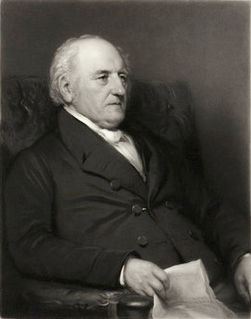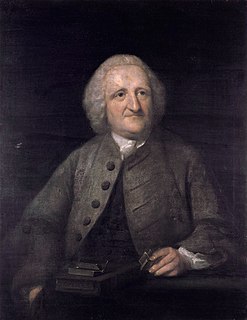Related Research Articles

Peter Barlow was an English mathematician and physicist.

An achromatic lens or achromat is a lens that is designed to limit the effects of chromatic and spherical aberration. Achromatic lenses are corrected to bring two wavelengths into focus on the same plane.

Flint glass is optical glass that has relatively high refractive index and low Abbe number. Flint glasses are arbitrarily defined as having an Abbe number of 50 to 55 or less. The currently known flint glasses have refractive indices ranging between 1.45 and 2.00. A concave lens of flint glass is commonly combined with a convex lens of crown glass to produce an achromatic doublet lens because of their compensating optical properties, which reduces chromatic aberration.

The history of the telescope can be traced to before the invention of the earliest known telescope, which appeared in 1608 in the Netherlands, when a patent was submitted by Hans Lippershey, an eyeglass maker. Although Lippershey did not receive his patent, news of the invention soon spread across Europe. The design of these early refracting telescopes consisted of a convex objective lens and a concave eyepiece. Galileo improved on this design the following year and applied it to astronomy. In 1611, Johannes Kepler described how a far more useful telescope could be made with a convex objective lens and a convex eyepiece lens. By 1655, astronomers such as Christiaan Huygens were building powerful but unwieldy Keplerian telescopes with compound eyepieces.

A refracting telescope is a type of optical telescope that uses a lens as its objective to form an image. The refracting telescope design was originally used in spyglasses and astronomical telescopes but is also used for long-focus camera lenses. Although large refracting telescopes were very popular in the second half of the 19th century, for most research purposes, the refracting telescope has been superseded by the reflecting telescope, which allows larger apertures. A refractor's magnification is calculated by dividing the focal length of the objective lens by that of the eyepiece.

John Dollond FRS was an English optician, known for his successful optics business and his patenting and commercialization of achromatic doublets.

An eyepiece, or ocular lens, is a type of lens that is attached to a variety of optical devices such as telescopes and microscopes. It is named because it is usually the lens that is closest to the eye when someone looks through the device. The objective lens or mirror collects light and brings it to focus creating an image. The eyepiece is placed near the focal point of the objective to magnify this image. The amount of magnification depends on the focal length of the eyepiece.

Jesse Ramsden FRS FRSE was a British mathematician, astronomical and scientific instrument maker. His reputation was built on the engraving and design of dividing engines which allowed high accuracy measurements of angles and lengths in instruments. He produced instruments for astronomy that were especially well known for maritime use where they were needed for the measurement of latitudes and for his surveying instruments which were widely used for cartography and land survey both across the British Empire and outside. An achromatic eyepiece that he invented for telescopes and microscopes continues to be known as the Ramsden eyepiece.

Peter Dollond was an English maker of optical instruments, the son of John Dollond. He is known for his successful optics business, and for the invention of the apochromat.

Dollond & Aitchison was one of the oldest chains of retail opticians in the United Kingdom, having been established in 1750. The business was absorbed into Boots Opticians in 2009 and stores were rebranded under the Boots Opticians name, completed in 2015.

Crown glass is a type of optical glass used in lenses and other optical components. It has relatively low refractive index (≈1.52) and low dispersion. Crown glass is produced from alkali-lime silicates containing approximately 10% potassium oxide and is one of the earliest low dispersion glasses.

The achromatic telescope is a refracting telescope that uses an achromatic lens to correct for chromatic aberration.
Chester Moore Hall was a British lawyer and inventor who produced the first achromatic lenses in 1729 or 1733 . He used the achromatic lens to build the first achromatic telescope, a refracting telescope free from chromatic aberration.
George Dollond was an English optician who constructed precision optical instruments used in astronomy, geodesy and also in navigation. Together with Peter Barlow, he also invented an afocal system to extend the focal length of telescopes, called the Barlow lens.
A scientific equipment optician is an individual who makes and adjusts other optical aids, including telescope optics and microscope lenses. See also Optician for individuals who make and adjust glasses.

The Shuckburgh telescope or Shuckburgh equatorial refracting telescope was a 4.1 inches (10.4 cm) diameter aperture telescope on an equatorial mount completed in 1791 for Sir George Shuckburgh (1751–1804) in Warwickshire, England, and built by British instrument maker Jesse Ramsden (1735–1800). It was transferred to the Royal Observatory, Greenwich in 1811 and the London Science Museum in 1929. Even though it has sometimes not been regarded as particularly successful, its design was influential. It was one of the larger achromatic doublet telescopes at the time, and one of the largest to have an equatorial mount. It was also known as the eastern equatorial for its location.

Robert-Aglaé Cauchoix was a French optician and instrument maker, whose lenses played a part in the race of the great refractor telescopes in the first half of the 19th century.
Edward Scarlett was an English optician and instrument maker, who first invented an eyeglass frame with earhooks in 1727. This frame is held by the nose and ears, at times the glasses were called in contrast to the nasal cannula and temples because they had short straps that pressed on the temple.
References
- ↑ Fred Hoyle, Astronomy; A history of man's investigation of the universe, Rathbone Books Limited, 1962, LCCN 62-14108
- ↑ J. A. B. "Peter Dollond answers Jesse Ramsden". Sphaera 8. Museum of the History of Science, Oxford . Retrieved 27 November 2017.- A review of the events of the invention of the achromatic doublet with emphasis on the roles of Hall, Bass, Jesse Ramsden, John Dollond and others.